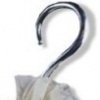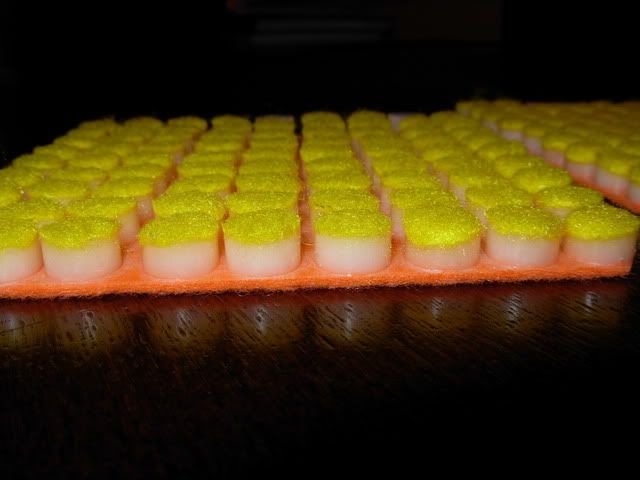Also, a big thanks to all the people who want to buy foam, who I have blown off to work on darts. I'll probably continue to do that for a while, because I just think this is more important.
The Dart Progress Chart (I'll try to update this regularly)
Key:
No progress
+Progress, but not good enough
++Good enough, but there's room for improvement or more testing needed to confirm
+++Done, finished, perfect.
Goals:
++Better durability than slugs
+++Safer damaged darts than slugs
Hurts less than slugs
+Hurts less than glue domes
++Better aerodynamics than slugs
+Feeds through a hopper system reliably
+Materials Cheap
Labor Cheap


The current rubber darts have the tips molded into a blank with a hole drilled in it. As a consequence, the texture of the cut foam creates a grip for the rubber. No adhesive was used, because no adhesive would work with those two materials. 3 variants have been made, one with a 1/2” diameter dome 3/16” tall, one with 7/16” diameter 3/16” tall, and one with 7/16” diameter 5/32” tall. The current favorite for feeding reliably is the 7/16” diameter x 3/16” tall, which weigh about 1.1g, although the 1/2” x 3/16” 1.5g darts look the best and are the easiest to produce reliably.
Probably the hardest of my criteria to satisfy is the hopper system. Rubber has a high coefficient of friction with most materials, which makes them prone to misfeeds if the dart head needs to drag along a surface to fire. We originally wanted to make our darts work reliably with the traditional pvc wye hoppers, but this seems increasingly unreasonable as it pretty much rules out rubber for the head.
The first wye modification that I tried was the cotton T-shirt cloth. Affixed with hot-glue in a tremendously awkward manual process, these were the first time that I got rubber darts to feed through a hopper every shot. For at least a couple hundred shots. The cotton served as a slightly lower friction interface than the PVC

Soon afterward I used a thin felt pad was used in similar capacity, with about 1-2% misfeed. Ryan tried some adhesive backed Teflon tape (Don't ask how they make it, I don't know), and that seemed to work about as well as an unadulterated wye.
So, with a great deal of help from Ryan many cotton wyes were made, many prototype darts were made, and much testing was done. The cloth-wyes pooped darts sometimes, although they never jammed and very rarely failed to fire. The frequency and severity seemed to vary between wyes of the same basic make, so I assumed that the issue was a matter of quality on the cloth-wyes, which were so awkward to make. I made a bunch of wyes, and resolved to test and use the best ones and pick before APOC. My new hopper fired reliably, albeit with inconsistent power, while Ryan's older and more used hopper basically stopped working better than a regular wye. As the war progressed my hopper's performance deteriorated somewhat, so I'm guessing that the cloth/hotglue combo is not very wear resistant.
So, for now I've given up on improving the coefficient of friction, and focused on improving the structure of the hopper so that the dart seals faster and avoids most of the friction problems and bending problems.
My first approach only attempted to solve the dart seal problem, because I could do that with hardware store parts and some nylon tubes I had laying around. 5/8” OD, thin walled material of most any kind could be used to similar effect. The design was based on the semi-auto shotgun
http://nerfhaven.com...=1
feed mechanism, but reduced to one dart at a time, and downsized to improve dart seal. This required shortening the 1/2” CPVC couplers that were used to accommodate our dart length.

This worked amazingly well the first night that we tried it, and remain the best current option for hoppering my rubber tipped darts. They require much less volume to operate consistently than the traditional wye hoppers, which allows them to fire out of blasters like the Big Bad Bow and Big Salvo without any modification to the propulsion system (Although the BBBs air restrictor kept engaging when it was hoppered, so I had to sabotage it by shoving a drill down the barrel. No way am I going to try to fish that out.)
However, we noticed some swirling a la streamlines on day 2 of testing, only out of the more powerful blasters (PAC and RBP). About 2/3 fired like lasers, and the remaining 1/3 displayed some sort of anomalous behavior in their trajectory. The most common anomaly was the tail oscillating rapidly, with little affect on the trajectory other than slowing down the dart (which still got at least 70 flat), but streamline-like magic bullets did occur as well. Normally I'd blame this sort of thing on the darts rather than the hopper, but we've been using these same darts in the cotton hoppers and in single barrels for a few weeks now, and only seen this phenomenon with these latest hoppers. So my current best guess is that the sharp bend that the darts are pushed through is responsible for either deforming or producing some stored elastic energy in the dart.
My next move is to produce a hopper similar to the last one but with a nice gradual bend. I'm abandoning hardware store parts and reproducibility for this, and aiming for really cheap for us (Ryan and myself, aka MHA) to make so that we can just include them with every box of darts we sell. Some sort of cast plastic part is most likely the next step.
Some prototype fuzzy domes were made and did work in standard hoppers, although too few were made to confirm that they reliably fired at full power. The process for making them was basically to dip them in uncured rubber, press the tip into a cotton ball, and pick / cut away excess after it had cured. This process was difficult, unreliable, and wasteful. Also I suspected that they would deteriorate in a manner similar to slugs, so this has not been pursued further.
Edited by KaneTheMediocre, 18 August 2011 - 06:23 PM.





















